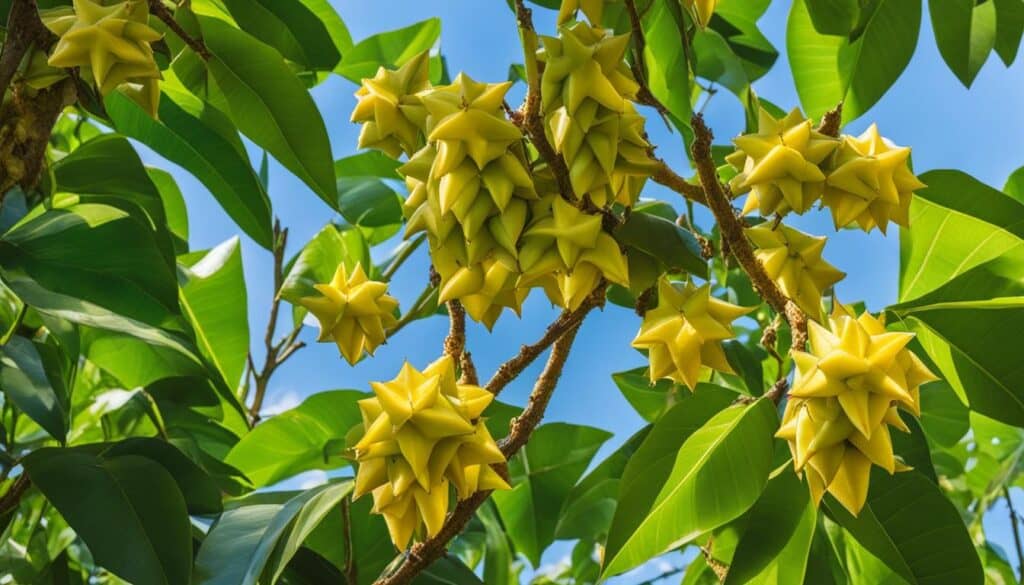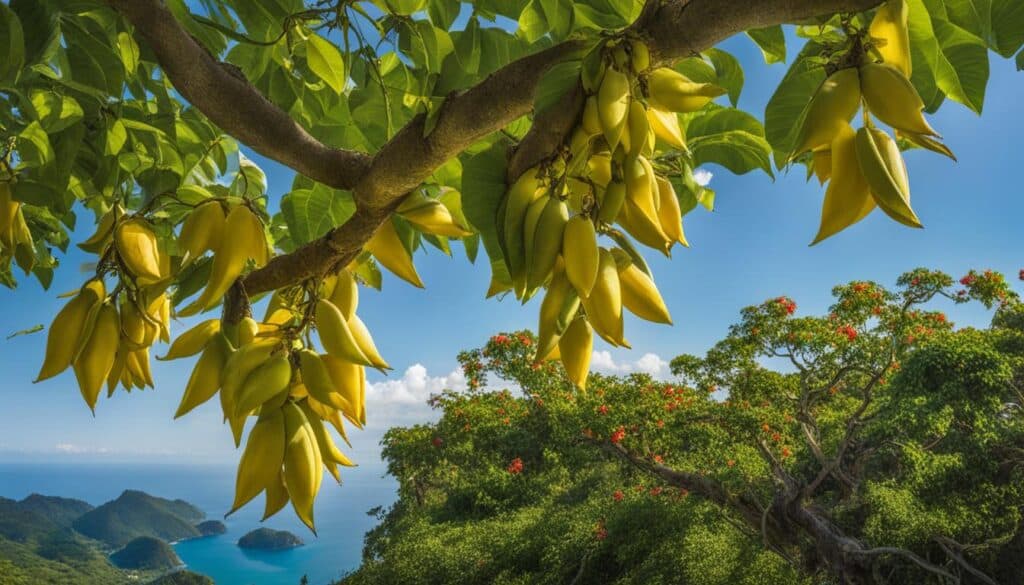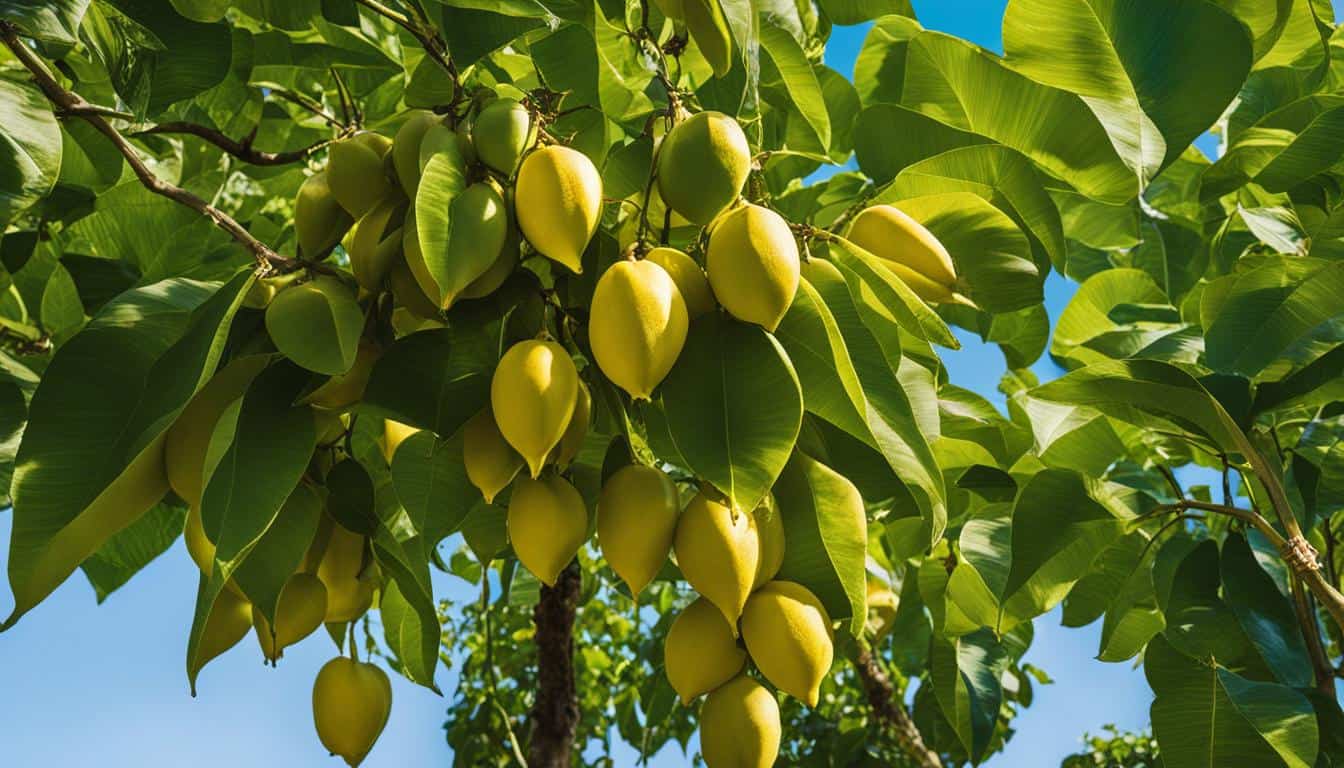Growing your own star fruit tree is a delightful and rewarding experience. Not only will you have the pleasure of watching this tropical beauty flourish, but you’ll also get to enjoy the delicious star fruits it produces. Whether you’re a seasoned gardener or just starting out, I’ll guide you through the simple steps to successfully grow and care for a star fruit tree.
First, start by purchasing ripe star fruits from your local grocery store. Carefully remove the seeds from the fruits, as these will be the key to growing your own tree. Next, plant the seeds in seed starter soil, making sure to keep the soil moist and cover it with plastic to maintain the necessary moisture. As the seedlings grow, gradually transfer them to larger containers.
It’s important to note that star fruit trees are tropical plants and are best grown in containers in non-tropical climates. To protect the tree from frost and freezing temperatures, either bring it indoors or provide suitable protection. Be patient, as it can take two to four years for your star fruit tree to bear fruit.
Key Takeaways:
- Growing a star fruit tree from seeds purchased at the grocery store is a simple process.
- Star fruit trees should be grown in containers in non-tropical climates.
- It can take two to four years for a star fruit tree to bear fruit.
- Star fruit trees require protection from frost and freezing temperatures.
- Enjoy the beauty and deliciousness of your own homegrown star fruit tree!
Benefits of Growing a Star Fruit Tree
Star fruits, also known as carambola, are not only delicious but also packed with nutritional benefits. They are low in calories and high in vitamin C, fiber, and antioxidants. Star fruits are known to have anti-inflammatory properties, boost immunity, improve respiratory and heart health, and aid digestion. It is important to note that star fruits contain oxalates and may not be suitable for individuals with kidney problems. Always consult with a healthcare professional before adding star fruits to your diet.
“Star fruits are not only delicious but also a powerhouse of nutrients.”
When it comes to star fruit facts, it’s hard to ignore their impressive nutritional profile. These tropical fruits are a rich source of vitamin C, which helps support a healthy immune system. They also provide a good amount of fiber, which promotes digestive health and helps maintain a healthy weight. Additionally, star fruits are packed with antioxidants, which protect the body against free radicals and reduce the risk of chronic diseases.
The health benefits of star fruits go beyond their nutritional content. They have been found to have anti-inflammatory properties, which can help reduce inflammation in the body and alleviate conditions such as arthritis. Star fruits also have positive effects on respiratory and heart health, thanks to their antioxidant and anti-inflammatory properties. Furthermore, their high fiber content aids in digestion and can help prevent constipation. However, it’s important to note that star fruits contain oxalates, which may be harmful to individuals with kidney problems, so it’s always best to consult with a healthcare professional before incorporating them into your diet.
Star Fruit Nutrition Facts
| Nutrient | Amount per 100g |
|---|---|
| Calories | 28 |
| Carbohydrates | 6g |
| Fiber | 2g |
| Vitamin C | 34.4mg |
| Vitamin A | 25IU |
| Potassium | 133mg |
“Star fruits are a delicious and nutritious addition to a balanced diet.”
With their delightful taste and abundance of health benefits, star fruits make a fantastic addition to any diet. Whether enjoyed fresh, added to salads, blended into smoothies, or used in various culinary creations, star fruits are a versatile fruit that can be incorporated into many recipes. Just remember to select ripe star fruits with vibrant yellow skin and rinse them before slicing. Remove the edges with higher oxalate concentrations for a safer consumption experience. So why not grow your own star fruit tree and reap the rewards of these delicious and nutritious fruits?
The Enchanting World of Starfruit

Starfruit, also known as carambola, is a tropical fruit native to Southeast Asia but is now cultivated in tropical areas worldwide. This fruit’s unique shape and taste make it a favorite among fruit enthusiasts. There are various starfruit varieties available, each with its own distinctive characteristics.
Starfruit Varieties
| Variety | Description |
|---|---|
| Sri Kembanqan | A popular variety known for its sweet flavor and crisp texture. |
| Fwang Tung | This variety has a tangy taste and is commonly used in culinary preparations. |
| Kari | Known for its vibrant yellow color and juicy flesh, this variety is a favorite for juices and desserts. |
| B-10 | A hybrid variety that combines the best qualities of other starfruit varieties. |
| Arkin | A small-sized variety with a sweet and slightly sour taste, perfect for snacking. |
Starfruit trees thrive in tropical and subtropical climates, with USDA zones ranging from 9 to 11. These trees require warm temperatures and plenty of sunlight to produce abundant and flavorful fruit. The starfruit season typically falls during the warm months, making it a delightful addition to summer menus.
Whether you enjoy the sweet and juicy Sri Kembanqan or the tangy Fwang Tung variety, starfruit is sure to captivate your taste buds and add a tropical touch to your culinary creations.
Ideal Conditions for Growing Starfruit
Growing a star fruit tree requires providing it with the ideal conditions to thrive and produce healthy fruit. Here are some key factors to consider when cultivating these tropical trees:
Sunlight:
Starfruit trees love sunlight and require full sun exposure for at least 6 to 8 hours a day. Choose a location in your garden or yard with ample sun exposure to ensure optimal growth and fruit production.
Soil:
The soil for starfruit trees should be well-draining and have a pH range of 5.5 to 7.5, slightly acidic to neutral. You can ensure proper drainage by amending the soil with organic matter such as compost or well-rotted manure. This will also help improve the fertility of the soil and retain moisture, promoting healthy root development.
Watering:
Starfruit trees require regular watering, especially during dry periods. Water the tree deeply, ensuring that the soil is evenly moist but not waterlogged. Avoid overwatering, as excessive moisture can lead to root rot.
Pruning:
To maintain the shape and promote healthy growth of your starfruit tree, regular pruning is essential. Prune any dead, damaged, or crossing branches. Additionally, selectively prune to maintain an open canopy, allowing sunlight and air circulation to reach all parts of the tree.
Frost Protection:
As tropical plants, starfruit trees are not frost-tolerant. If you live in a non-tropical climate, it’s important to protect your tree from freezing temperatures. You can bring the tree indoors during winter or provide adequate frost protection by covering it with a blanket or using frost cloth.
| Conditions | Requirements |
|---|---|
| Sunlight | Full sun exposure for 6-8 hours a day |
| Soil | Well-draining, pH range of 5.5-7.5 |
| Watering | Regular watering, evenly moist but not waterlogged |
| Pruning | Regular pruning to maintain shape and promote healthy growth |
| Frost Protection | Protection from freezing temperatures in non-tropical climates |
By providing your starfruit tree with these ideal conditions, you can ensure its growth and fruit production. Remember to take necessary precautions to protect the tree from frost and frostbite temperatures, as well as regular pruning and watering for optimal health. With proper care, you’ll be able to enjoy the delicious fruits of your starfruit tree for years to come.
How to Enjoy Starfruit
Starfruit, also known as carambola, is a versatile fruit that can be enjoyed in a variety of ways. Whether you prefer it fresh or incorporated into different recipes, here are some delicious ways to savor the unique flavors of starfruit:
Slice and Enjoy
The simplest way to enjoy starfruit is by slicing it crosswise to reveal the beautiful star-shaped slices. Make sure to select ripe star fruits with vibrant yellow skin for the best flavor. Rinse the fruit under cool water, remove the edges with higher oxalate concentrations, and then indulge in its crisp and juicy texture. The taste of starfruit is a delightful combination of apple, pear, and citrus flavors.
Incorporate in Salads and Juices
Starfruit adds a refreshing and tropical twist to salads and juices. Add sliced starfruit to your favorite salad greens, along with other fruits like strawberries or oranges, for a burst of flavor. You can also blend starfruit with other fruits to create refreshing juices or smoothies. Experiment with different combinations to find your perfect mix.
Create Culinary Delights
Get creative in the kitchen and use starfruit as an ingredient in various culinary creations. It adds a unique flavor and visual appeal to dishes such as chutneys, cocktails, desserts, and preserves. You can use starfruit as a topping for cakes or tarts, incorporate it into jams or jellies, or even use it as a garnish for tropical-themed cocktails. The possibilities are endless!
With its distinct taste and versatility, starfruit is a fruit that can elevate your culinary experience. Whether you enjoy it fresh or incorporate it into your favorite recipes, let the vibrant flavors of starfruit transport you to a tropical paradise.
| Starfruit Recipes |
|---|
| 1. Starfruit Salad |
| Ingredients: |
| – Ripe starfruit |
| – Salad greens of your choice |
| – Other fruits such as strawberries or oranges |
| – Dressing of your choice |
| Instructions: |
| – Rinse and slice starfruit crosswise |
| – Arrange salad greens on a plate |
| – Add sliced starfruit and other fruits |
| – Drizzle with your favorite dressing |
| – Toss gently and enjoy! |
| 2. Starfruit Smoothie |
| Ingredients: |
| – Ripe starfruit |
| – Other fruits of your choice (e.g., bananas, berries) |
| – Yogurt or milk |
| – Honey or sweetener (optional) |
| Instructions: |
| – Rinse and slice starfruit crosswise |
| – Add starfruit, other fruits, yogurt or milk, and sweetener to a blender |
| – Blend until smooth and creamy |
| – Pour into a glass and enjoy! |
Quote:
Indulge in the vibrant flavors of starfruit and let its tropical essence transport you to paradise.
Challenges of Growing Starfruit and How to Resolve

Growing a star fruit tree comes with its fair share of challenges, but with proper care and attention, these obstacles can be overcome. From climatic challenges to pests and diseases, it’s important to be aware of the potential issues that may arise and have a plan to address them.
“The key to successfully growing starfruit trees is to provide them with the right growing conditions and promptly address any challenges that may arise.”
1. Climatic Challenges:
Starfruit trees thrive in tropical and subtropical climates, so if you live in a non-tropical region, you’ll need to take extra precautions to protect your tree from cold temperatures and frost. Consider growing your star fruit tree in a container so that you can bring it indoors during colder months or cover it with a frost blanket. This will help ensure the tree’s survival and prevent damage to the fruit.
2. Wind Damage:
Strong winds can pose a threat to starfruit trees, especially when they are laden with fruit. To protect your tree, consider planting it in a sheltered location or using windbreaks such as fences or hedgerows to minimize the impact of strong gusts. Pruning the tree to maintain a balanced shape can also help reduce wind resistance and prevent damage.
3. Pests and Diseases:
Like any fruit tree, starfruit trees are susceptible to pests and diseases. Common pests that may affect starfruit trees include aphids and fruit flies. Regularly inspect your tree for any signs of infestation and take appropriate measures, such as using insecticidal soaps or organic insecticides, to control the pests. Additionally, starfruit trees can be prone to fungal infections, so ensure proper air circulation and avoid over-watering to prevent the development of these diseases.
| Challenge | Resolution |
|---|---|
| Climatic Challenges | Protect the tree from cold temperatures and frost by growing in a container or providing frost protection. |
| Wind Damage | Plant the tree in a sheltered location or use windbreaks to minimize the impact of strong winds. |
| Pests and Diseases | Regularly inspect the tree for pests, use appropriate control measures, and ensure proper air circulation to prevent fungal infections. |
By taking these steps to resolve the challenges of growing starfruit, you can ensure the health and vitality of your tree and enjoy a bountiful harvest of delicious star fruits.
Choosing the Right Location and Planting a Star Fruit Tree
When it comes to growing a star fruit tree, choosing the right location is essential for its successful development. The tree thrives in full sun exposure, so find a spot in your garden that receives ample sunlight throughout the day. Avoid areas with shade or partial shade, as it may hinder the tree’s growth and fruit production.
The soil in which you plant your star fruit tree should be well-draining and slightly acidic to neutral. You can amend the soil with organic matter to improve its fertility and moisture retention. This will provide the tree with the necessary nutrients and ensure proper growth.
Once you have selected the ideal location and prepared the soil, it’s time to plant your star fruit tree. Dig a hole slightly larger than the root ball of the tree, ensuring that it can fit comfortably. Place the tree in the hole, making sure it is upright and not slanted. Backfill the hole with soil, gently packing it around the roots to provide stability to the tree. After planting, water the tree thoroughly to help it settle into its new home.
Proper Care and Maintenance
After planting, it is crucial to provide your star fruit tree with regular care and maintenance. Water the tree regularly, ensuring that the soil is consistently moist but not waterlogged. Overwatering can lead to root rot, so be mindful of the moisture levels.
“The key to successful star fruit tree care is maintaining a balance of water and proper drainage. Remember to provide the tree with enough water without drowning the roots.”
In addition to watering, pruning is an essential aspect of star fruit tree care. Regular pruning helps maintain the shape of the tree, promotes healthy growth, and allows for better air circulation. It is advisable to prune during the dormant season or after the harvest to minimize stress on the tree.
| Star Fruit Tree Care Checklist |
|---|
| Choose a location with full sun exposure |
| Ensure well-draining and slightly acidic to neutral soil |
| Amend the soil with organic matter for added fertility |
| Plant the tree upright, backfill with soil, and water thoroughly |
| Water regularly, ensuring consistent moisture levels |
| Prune during the dormant season or after harvest |
By following these guidelines for choosing the right location and planting your star fruit tree, you can set the stage for a healthy and fruitful tree. With proper care and maintenance, you’ll soon be enjoying the delicious star fruits that your tree produces.
Time to Fruit and Growth Duration of Starfruit Trees

Growing a star fruit tree is an investment of time and patience, as it can take two to four years for the tree to bear fruit. The exact time to fruit can vary depending on factors such as the cultivar, growing conditions, and cultural practices. However, with proper care and attention, you can help expedite the fruiting process and enjoy the bountiful harvest.
During the initial stages of growth, it is important to provide the star fruit tree with the right conditions to promote healthy development. Regular watering, fertilizing, and protection from adverse weather conditions are essential for nurturing the tree. Adequate sunlight exposure and well-draining soil with a slightly acidic to neutral pH range are also crucial for optimal growth.
As the star fruit tree matures, it will gradually start producing flowers, which will eventually develop into fruit. The time it takes for the tree to reach this stage can vary, but consistent care and favorable conditions will help speed up the process. Regular pruning to maintain the tree’s shape and remove dead or damaged branches can also contribute to a healthier tree and more efficient fruiting.
| Factors Affecting Time to Fruit | Potential Impact on Fruit Production |
|---|---|
| Cultivar or Variety | Different varieties may have varying fruiting times |
| Growing Conditions | Unfavorable conditions can delay fruit production |
| Cultural Practices | Improper care and maintenance can hinder fruiting |
| Tree Age | Younger trees may take longer to bear fruit |
Remember to have patience and give your star fruit tree time to establish itself before expecting a harvest. As the tree matures and begins to bear fruit, you will be rewarded with the enchanting taste and unique star-shaped appearance of the star fruits.
Continue to provide attentive care and continue learning about the specific needs of your star fruit tree. By staying dedicated to its well-being, you can ensure a fruitful and enjoyable experience as you watch your tree flourish and provide you with its delicious bounty.
Conclusion
Growing your own star fruit tree can be a fulfilling journey that allows you to enjoy the beauty of the tree and the deliciousness of the star fruits it produces. Taking a few simple steps and providing proper care will ensure a thriving star fruit tree in your garden.
Remember to choose a suitable location with full sun exposure and protect the tree from strong winds. Plant it in well-draining soil and regularly water and prune it to maintain its health and shape. If you live in a non-tropical climate, be sure to protect the tree from cold temperatures.
While challenges may arise, such as dealing with pests or diseases, addressing them promptly will help keep your star fruit tree healthy and productive. Take the time to inspect your tree regularly and provide the necessary care it needs.
Embrace the enchanting world of starfruit and revel in the delightful flavors and health benefits it offers. By growing your own star fruit tree, you can experience the joy of nurturing a plant and enjoying the fruits of your labor.
FAQ
Can I grow a star fruit tree from seeds purchased at the grocery store?
Yes, growing a star fruit tree from seeds purchased at the grocery store is a simple and rewarding process.
How long does it take for a star fruit tree to bear fruit?
It can take two to four years for a star fruit tree to bear fruit.
What are the nutritional benefits of star fruits?
Star fruits are low in calories and high in vitamin C, fiber, and antioxidants. They are known to have anti-inflammatory properties, boost immunity, improve respiratory and heart health, and aid digestion. However, individuals with kidney problems should consult with a healthcare professional before adding star fruits to their diet due to the presence of oxalates.
What are some popular star fruit varieties?
Some popular star fruit varieties include Sri Kembanqan, Fwang Tung, Kari, B-10, and Arkin.
What are the ideal conditions for growing starfruit?
Starfruit trees thrive in frost-free areas with temperatures between 65°F and 95°F. They require full sun exposure and well-draining soil with a slightly acidic to neutral pH range of 5.5 to 7.5. Regular watering, fertilizing, and pruning are also important for their growth.
How can I enjoy starfruit?
Starfruit can be enjoyed fresh or incorporated into various culinary creations such as salads, juices, smoothies, chutneys, cocktails, desserts, and preserves. Simply select ripe star fruits, rinse them under cool water, and slice them crosswise to reveal star-shaped slices. Remove the edges with higher oxalate concentrations before consumption.
What challenges can arise when growing starfruit and how can they be resolved?
Some challenges when growing starfruit include climatic challenges, wind damage, pests, and diseases. Starfruit trees are sensitive to cold temperatures and frost, so they should be protected in non-tropical climates. Strong winds can damage the tree and its fruit. Pests such as aphids and fruit flies, as well as fungal infections, can also affect starfruit trees. Regular care, inspections, and prompt treatment can help resolve these challenges.
How do I choose the right location and plant a star fruit tree?
Choose a location that receives full sun exposure and is protected from strong winds. The soil should be well-draining and slightly acidic to neutral. Prepare the soil by amending it with organic matter. Dig a hole slightly larger than the root ball of the tree, place the tree in the hole, and backfill with soil. Water the tree thoroughly after planting and continue to water it regularly. Pruning can be done to shape the tree and promote healthy growth.
How long does it take for a star fruit tree to bear fruit?
It can take two to four years for a star fruit tree to bear fruit. The time to fruit depends on various factors such as the cultivar, growing conditions, and cultural practices.
Source Links
- https://www.greendreamsfl.com/single-post/growing-starfruit-trees-how-to-grow-carambola
- https://www.mansfieldnewsjournal.com/story/life/2023/01/17/grow-your-own-star-fruit-by-first-planting-seeds-indoors/69802218007/
- https://easilygrowngarden.com/how-to-grow-a-star-fruit-tree-from-seed-from-the-grocery-store/





Leave a Reply